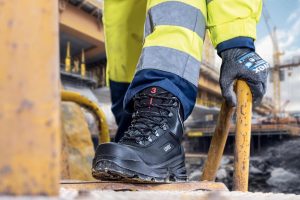The real cost of safety eyewear
Graham Abbott makes the case for investing in quality
safety eyewear and explains why there’s often more to
buying safety spectatcles than meets the eye
‘You get what you pay for’ is a
maxim often heard and very
rele
Graham Abbott makes the case for investing in quality
safety eyewear and explains why there’s often more to
buying safety spectatcles than meets the eye
‘You get what you pay for’ is a
maxim often heard and very
relevant to the purchase of
safety spectacles. Buying low cost basic
imported safety spectacles will in fact
calculate to be the more expensive way of
protecting your employees, it’s possible
to pay as little as £2 for a pair of basic
spectacles which will meet the European
standard, however, their performance
more often than not falls short when
subjected to the demands of the real
world environment.
When buying safety eyewear, too often a
company will base their decision as to
which brand and type to purchase almost
entirely on its price tag, but there is one
important factor that is worth
remembering, apart from quality,
durability, comfort, style and effectiveness
of the product, and that is its real cost, by
which we mean the cost when actually in
use.
More often than not better quality
product can actually be less expensive
than a cheap one in the long run, because
it will need replacing less often and will
have an extended product life. Although
safety managers may be well aware of this,
they often have a hard time putting across
the case for a more expensive product to
those holding the purse strings, especially
in these challenging times when many
procurement budgets have been frozen or
reduced. But more often than not the
more money spent on safety eyewear, the
more value for money ultimately gained.
Damage to the eyes is one of the most
common personal industrial injuries.
According to the Health and Safety
Executive (HSE), there are around 2,500
reportable eye injuries each year in the
UK, although, because of underreporting,
particularly in the construction
and manufacturing industries where eye
injuries predominantly occur, the real
number is believed to be considerably
higher.
Coatings
Protective eyewear is often used in harsh
working environments, so the lenses are
usually coated to increase their efficacy
and longevity. This coating is more
important than one might at first think
and is a key factor in ensuring the eyewear
is worn and thus the wearers protected.
For maximum effectiveness, lens coating
should offer resistance against fogging and
scratching. But lens coatings need to be
cost effective in use as well as reliable in
performance and for this they need a long
or extended life.
Lens coatings can either be hydrophobic
(moisture repelling) detergent-based
coatings (which can be washed off) or
hydrophilic (moisture absorbing). A
hydrophobic coating repels moisture
which ultimately leads to a build up of
perspiration on the lens which in turn
requires cleaning to remove it – eventually,
depending on the quality of the coating the
detergent properties will be washed from
the lens, rendering it ineffective.
It’s possible however to produce
hydrophilic coatings which are permanent
and do not wash off. The coating becomes
sponge-like, absorbing moisture so that
the wearer does not have to take off their
spectacles or goggles to clear any fog,
enhancing both safety and wearer
compliance.
Testing
Safety eyewear is subject to a series of
optional tests, under European Standard
EN 168:2001, which covers non-optical
test methods on personal eye protection.
Under this standard, lenses may be tested
for resistance to surface damage by fine
particles, carrying the symbol ‘K’
accompanying the CE mark supplied by
the manufacturer of they meet this
requirement. They may also be tested for
resistance to fogging. The test requires
that the lenses remain fog free for a
minimum of eight seconds when exposed
to an atmosphere above 50 degrees C.
Lenses that meet this standard are marked
with the symbol ‘N’. It is important to
ensure that safety eyewear meets and
preferably exceeds this voluntary
standard.
As part of its ongoing research and
development into lens coatings, uvex
recently conducted in-house tests on the
durability of the lens coatings of its and
other manufacturers’ safety spectacles by
repeatedly washing them to see how
quickly the anti-fog coating deteriorated,
assuming two washes per week through
44 weeks per year.
The tests’ results demonstrate to the
buyer that they must consider the product
in more ways than just its price per unit,
however important this is. They need to
take the wider perspective view and think
about the real cost of the product over a
period of time.
Taking into account the cost of safety
eyewear, a simple calculation can be done
to ascertain the ‘cost in use’ or value of
the products over the annual usage of an
average person. The average spend per
person shows that the user of the
spectacles costing £2 each would go
through 22 pairs a year, costing an
average £44 per person, while those using
spectacles costing £6 per pair would only
need 3.6 pairs in a year because the antifog
coating lasts indefinitely – total cost
£21.60 per person per year. This test
clearly demonstrates that it is a false
economy to skimp and buy the cheaper
spectacles.
Graham Abbott is the sales and marketing
director of uvex UK.
HSM publishes a weekly eNewsletter, delivering a carefully chosen selection of the latest stories straight to your inbox.
Subscribe here






